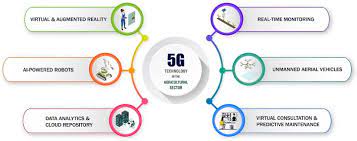I. Introduction
The agricultural landscape is undergoing a digital transformation, and the advent of 5G technology is playing a pivotal role in shaping the future of farming. This article explores the profound impact of 5G on smart agriculture, from precision farming and connected devices to data-driven decision-making that promises to revolutionize the way we cultivate and manage crops.
II. Accelerating Connectivity with 5G
The rollout of 5G networks signifies a quantum leap in connectivity. This section examines how 5G’s faster and more reliable communication capabilities empower farmers with real-time access to data. From remote field monitoring to instant communication between devices, 5G accelerates connectivity, forming the backbone of smart agriculture.
III. Precision Farming and IoT Integration
5G acts as an enabler for Precision Farming by seamlessly integrating with the Internet of Things (IoT). This section delves into how 5G facilitates the connectivity of smart sensors, drones, and autonomous machinery. The real-time data exchange allows farmers to make informed decisions, optimize resource utilization, and enhance overall crop yield.
IV. Enhanced Remote Monitoring and Control
With 5G, remote monitoring and control of agricultural operations reach unprecedented levels of efficiency. This section explores how farmers can monitor soil conditions, crop health, and equipment status in real-time. The ability to remotely control machinery and irrigation systems contributes to resource conservation and operational flexibility.
V. Autonomous Vehicles and Smart Machinery
5G’s low latency and high data transfer rates are a game-changer for autonomous vehicles and smart machinery in agriculture. This section discusses how 5G enables the seamless communication between unmanned tractors, harvesters, and drones. The result is increased operational efficiency, reduced labor costs, and more precise farming practices.
VI. Data-Driven Decision-Making
Data is at the heart of smart agriculture, and 5G enhances the scope and speed of data-driven decision-making. This section explores how real-time data analytics empower farmers to monitor crop performance, predict disease outbreaks, and optimize irrigation schedules. Informed decisions lead to increased productivity and sustainability.
VII. Smart Irrigation Systems
Water scarcity is a critical challenge in agriculture, and 5G contributes to the development of smart irrigation systems. This section examines how 5G enables precise monitoring of soil moisture levels and weather conditions. Smart irrigation systems adjust water delivery in real-time, promoting water conservation and efficient irrigation practices.
VIII. Crop Monitoring with High-Resolution Imagery
5G facilitates the use of high-resolution imagery for detailed crop monitoring. This section discusses how drones equipped with advanced cameras can capture high-quality images of crops. The real-time transmission of this imagery allows farmers to assess crop health, identify potential issues, and take proactive measures for crop management.
IX. Improved Supply Chain Management
Efficient supply chain management is vital in agriculture, and 5G enhances traceability and logistics. This section explores how 5G enables real-time tracking of produce from farm to market. Enhanced supply chain visibility reduces waste, ensures product quality, and provides consumers with greater transparency about the origin of their food.
X. Environmental Monitoring and Sustainability
5G empowers farmers to monitor and enhance environmental sustainability. This section discusses how sensors and connected devices can collect data on environmental parameters, allowing farmers to adopt sustainable practices. From reducing chemical usage to optimizing energy consumption, 5G contributes to environmentally conscious agriculture.
XI. Challenges and Considerations
While the impact of 5G on smart agriculture is transformative, challenges and considerations exist. This section explores issues such as infrastructure deployment, data security, and the need for farmer education. Addressing these challenges is essential to realizing the full potential of 5G in the agricultural sector.
XII. Future Developments and Innovations
The future of smart agriculture with 5G holds exciting possibilities. This section discusses potential developments, including the integration of Artificial Intelligence (AI) for predictive analytics, the expansion of smart agriculture applications, and the evolution of 5G networks to meet the evolving needs of the agricultural industry.
XIII. Conclusion
In conclusion, the impact of 5G on smart agriculture is transformative, ushering in an era of connectivity and data-driven farming practices. From precision farming and autonomous vehicles to improved supply chain management and environmental sustainability, 5G is revolutionizing every aspect of agriculture. As the technology continues to evolve, smart agriculture powered by 5G promises increased efficiency, sustainability, and resilience for farmers around the globe.
FAQs
- How does 5G accelerate connectivity in smart agriculture? 5G accelerates connectivity in smart agriculture by providing faster and more reliable communication capabilities. This empowers farmers with real-time access to data, facilitating remote field monitoring, and instant communication between connected devices.
- What is the role of 5G in precision farming and IoT integration? 5G seamlessly integrates with the Internet of Things (IoT) to enable precision farming. It facilitates the connectivity of smart sensors, drones, and autonomous machinery, allowing real-time data exchange. This integration optimizes resource utilization and enhances overall crop yield.
- How does 5G contribute to data-driven decision-making in agriculture? 5G enhances data-driven decision-making in agriculture by providing real-time data analytics. Farmers can monitor crop performance, predict disease outbreaks, and optimize irrigation schedules. Informed decisions lead to increased productivity and sustainability.
- What are the benefits of 5G in autonomous vehicles and smart machinery in agriculture? 5G’s low latency and high data transfer rates enable seamless communication between autonomous vehicles and smart machinery in agriculture. This results in increased operational efficiency, reduced labor costs, and more precise farming practices.
- How does 5G improve supply chain management in agriculture? 5G improves supply chain management in agriculture by enabling real-time tracking of produce from farm to market. Enhanced supply chain visibility reduces waste, ensures product quality, and provides consumers with greater transparency about the origin of their food.
